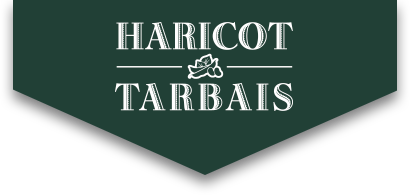The Tarbais Bean
a traditional and reasoned culture
Tarbais beans cultivation requires compliance with a schedule of conditions and a process, from soil preparation to harvesting and ginning, through reasoned interventions.

Tarbais beans belong to the family of legumes, characterized by their ability to develop nodules, true nitrogen traps.
To develop, these nodules need an airy soil, little packed and therefore well prepared and maintained.
The farmer therefore practices soil decompaction in the spring in order to "break" all the "existing footings" (plowshares) as well as the "crusts of flapping" (superficial soil compaction) formed during the winter period.
It must be done between April 25th and May 30th.
Soils have warmed up (about 15 ° C), which will facilitate germination and emergence.
In order to promote sunshine and tillage during cultivation (hoeing), the distance between rows is 1.20 m minimum. The distance between the legs is at least 20 cm.
The registered seeds for the Tarbais bean crop are Alaric and Lapujole.
The Tarbais Bean is a climbing plant that needs a guardian to grow. Two guardians are allowed: the net and the corn.
The staking on guard net takes place in the month following sowing, at the moment when the bean starts to pull the spin. On each row of beans, stakes of 2.40 m height are implanted every 5 m. A string is then stretched at the upper and lower ends of the pegs throughout the row. The nets are then unrolled over the entire length and hung on the stakes and strings.
In the case of maize staking, bean and maize seedlings are planted the same day on the same sowing line so that the bean can easily find corn. Corn is sown first a little deeper.
The specifications impose two binages (that is to say loosen the surface layer of the soil around the cultivated plants) to a minimum, but most producers realize more.
Indeed tillage is essential to aerate the soil, increase and facilitate the deep rooting of plants and maintain a good cleanliness of the plot. We can therefore operate on the entire Tarbes Bean cycle.
It is also recommended to butter the rows to limit the effects of soil fungi and grassing Tarbes beans rank. This will allow the plants to develop new roots above the diseased area and to smother the small grasses being developed.
Throughout the crop, depending on the observations and / or the results of various analyzes, the producer decides a number of interventions among which: fractional fertilization, fight against fungi, insects and other pests, irrigation.
He is accompanied for this by the technical service of the Cooperative.
Once dry on the plant (one must hear the grain ring in the pod), the precious white bean is picked up with its pod, from late September until mid-November.
Each producer uses seasonal workers or family labor. This is nearly 300 to 400 collectors who come to Tarbais bean fields every year, coming mainly from Occitanie but also from other regions of France!
The harvest is carried out plot by plot and guardian by tutor to ensure full traceability.
It is done at the producer's. It is made mechanically using a tool with an egrenoir.
Once the grain is separated from the pod, the producer delivers his harvest to the Cooperative located in Tarbes.







